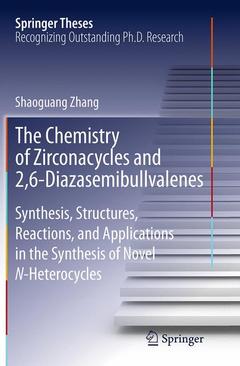Description
The Chemistry of Zirconacycles and 2,6-Diazasemibullvalenes, Softcover reprint of the original 1st ed. 2015
Synthesis, Structures, Reactions, and Applications in the Synthesis of Novel N-Heterocycles
Springer Theses Series
Author: Zhang Shaoguang
Language: English
Subjects for The Chemistry of Zirconacycles and 2,6-Diazasemibullvalenes:
Publication date: 08-2016
Support: Print on demand
Publication date: 11-2014
173 p. · 15.5x23.5 cm · Hardback
Description
/li>Contents
/li>Comment
/li>
In this thesis, the author introduces two strategies used to construct various types of N-heterocycles, based on the chemistry of zirconacycles and 2,6-diazasemibullvalenes. In the first part, the author presents the development of multi-component cyclization of a zirconacyclobutene-silacyclobutene fused compound, nitriles and unsaturated compounds. These reactions provide synthetically useful methodology for various N-heterocycles such as 3-acyl pyrrole, pyrrolo[3,2-d]pyridazine and dihydropyrroloazepine, which are all difficult to synthesize by other means. The isolation and characterization of the key three-fused-ring Zr/Si-containing intermediates are also described in detail. These results show that the zirconacyclobutene-silacyclobutene fused compound behaves as a ?chemical transformer? upon treatment with various substrates via the ?coordination-induced skeleton rearrangement? mechanism. In the second part, the author demonstrates the synthesis and isolation of a series of 2,6-diazasemibullvalenes (NSBVs) from the reaction of 1,4-dilithio-1,3-dienes and nitriles, highlighting the significant progress made for the first time in this work: (1) determination of X-ray crystal structure of a substituted 2,6-diazasemibullvalene; (2) measurement of the activation barrier of its rapid intramolecular aza-Cope rearrangement in solution; (3) exploration of several reaction types of NSBV with diverse ring-expansion products and ?bowl-shape? or ?cage-shape? N-containing polycyclic skeletons; (4) demonstration of the localized structure as the predominant form and the homoaromatic delocalized structure as a minor component in the equilibrium using theoretical analysis. Based on well-founded results, this work sheds new light on this controversial topic.
These books may interest you

Advances in Heterocyclic Chemistry 193.44 €

Advances in Heterocyclic Chemistry 203.23 €


